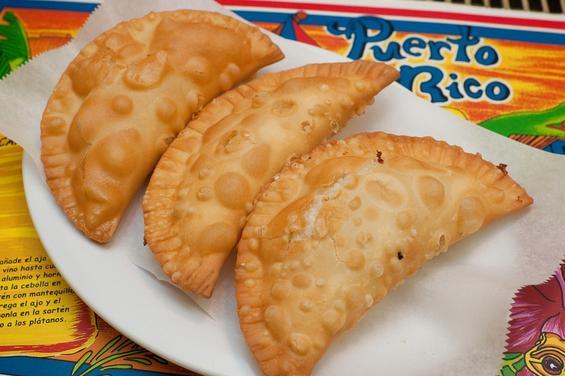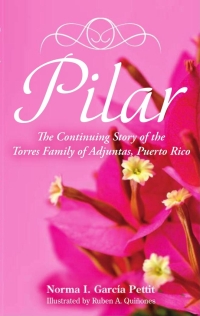Pastelillos or Empanadillas?
Food being an important part of any culture, there are descriptions of typical Puerto Rican cuisine scattered throughout Luisa. With no restaurants in their mountain community (and no money with which to eat out even if there was a nearby restaurant), and no lasagnas or pizzas in the freezer (indeed, no freezer or even electricity in their home), cooking for their large family was an integral part of Chenta and Luisa’s daily activities. Some of the dishes mentioned in the book include vianda con bacalao, arroz con gandules, pollo guisado, pasteles, empanadillas, dulce de coco, arroz con pollo, and domplines.

Let’s talk about empanadillas. In Chapter 16, Luisa prepares them to take to a party at the home of Lucas Maldonado and his wife, Antonia Sáez. You may know them as pastelillos or empanadas instead of empanadillas. Some years ago, I posted this question on a Facebook page:
Do you consider empanadillas/empanadas to be the same thing as pastelillos? My mother always called her meat turnovers empanadillas, and I always thought that pastelillos had fruit filling, like for example, un pastelillo de guayaba (a guava turnover). However, at food trucks and other food vendors, I often see pastelillos de carne o de jueyes (meat or crab turnovers) on the menu. Is it because of a regional difference in lingo? My mother was born in Adjuntas, but her family moved to Ponce at some point.
I got all kinds of answers! These are a few of the 27 comments that were posted.
— I always thought of the meat filled as pastelillos. It wasn’t until I was an adult that I heard empanadas used as the same thing.
—Pastelillos and empanadillas differ due to the “plantilla” used. The pastelillos use the really yellow plantilla while the empanadillas use the whiter and larger plantilla. The pastelillo is usually closed using a fork while the empanadilla is closed by fold/twisting the edge. (To which I responded, “I close my empanadillas with a fork, like my mother did. I fill them with seasoned ground beef that includes capers and raisins.”)
— I was taught that Pastelillos were pork and Empanadas were beef.
—Empanadilla was what we called our meat turnover or savory turnover. Pastelillos were dessert or sweet turnovers. Both were made with the same masa from scratch (honestly never knew there was something else you could use). I started calling them empanadas later in life because I heard other people doing it and different cultures also called them that.
—When I was in high school in Trujillo Alto, we ate lunch at a corner little restaurant and we had a choice of pastelillos de carne o de guayaba. I always heard the crispy thin turnovers called pastelillos even in other areas of the island. Empanadas had a thicker different dough and had more filling in them. That is what I remember from my days. But I learned that when the Cubans and Dominicans moved to PR some of our names for things were changed. Even my mother started using the new names because everyone else was. Years later I went to the grocery store and saw so many of the produce names changed. Now I think only the older generations remember the original names.
—No, absolutely not, they are variations. Empanadillas/empanadas are larger in size. Pastelillos are smaller. They both contain meat, like beef, pork, ground turkey, cheese, guayaba paste or crab meat. But it is also true that though our island is small we do call our dishes by different names.
So, as you can see, there is a wide variety of opinions on the subject! I have come to the conclusion that “a rose is a rose by any other name.” If you see pastelillos on the menu, call them by that name when ordering; if you see them referred to as empanadillas, do the same.
Here is an excerpt from Chapter 16 that describes Luisa making empanadillas. Where you see “…”, I have eliminated some text that was not part of the cooking process.
Luisa was only ten years old when her mother died, but making beef empanadillas was something that she had watched her mother do many times, and that was the one recipe of her mother’s that she used. Everything else she had learned from Chenta.
She began by mincing beef. This was a time-consuming task, but Luisa was able to sit at the table to do it. Through the open window she could hear her beloved ruiseñor serenading her, and through the open kitchen door she could catch glimpses of her younger siblings playing in the batey…
With the meat finally minced, Luisa cooked it in a pot with onions, garlic, green peppers, capers, recao and achiote, adding salt to taste. Then, leaving the meat to cool, she made the dough. Using flour, water, lard, and salt, Luisa kneaded the dough until it was well blended and of a pliable consistency. She rolled out a ball of the dough on a floured board on the kitchen table and cut out circles by pressing down and twisting half of a small coconut shell. She spooned a little mound of meat onto the center of a circle, added a couple of raisins to it, dipped her fingers in a bowl of water and wet the circumference of the dough. She folded the circle in half, and dipping a fork into flour, used it to pinch the edges of the meat turnover together, making a pattern of tiny lines all around the edge. Pilar, finished with her chores, came in and helped Luisa with this part of the process, and when they were done, she counted over two dozen beautiful turnovers.
Now came the job of frying them. Standing over a hot stove frying two or three empanadillas at a time was a tiring job, even if the December mornings in the mountains of Adjuntas were cool. The tiny kitchen was stifling, as the only ventilation was the occasional breeze that blew in through the window or the kitchen door that opened out to the porch...
The empanadillas were all fried, with crisp golden-brown edges, bumpy dough on the outside and savory meat on the inside. They had taken most of the morning to prepare. Luisa put them in a deep pan which she covered with a clean kitchen towel, hoping that no one would sneak any while she was getting ready.
Just as with Luisa, making empanadillas was something that I learned from watching my mother. One difference, however, is that I cheat on the dough by using store bought dough circles specifically made for baking—not frying--empanadillas. My mother always baked hers, and I have continued the tradition. With the store bought circles, I am guaranteed a light, flaky crust, and they make the preparation so much easier. You can prepare a couple dozen empanadillas and keep them frozen for unexpected dinner guests or for when you have a lazy night and don’t feel like cooking (just pair them with a nice salad). I currently have some in my freezer, ready for an upcoming family reunion. ;-)
